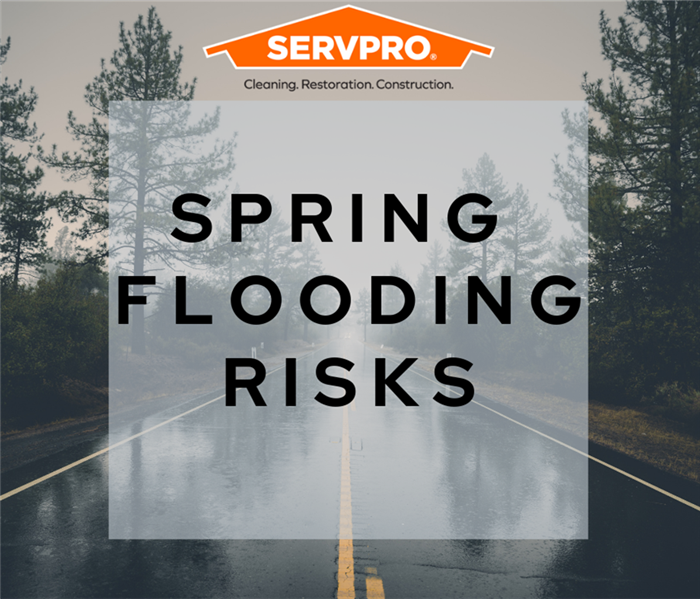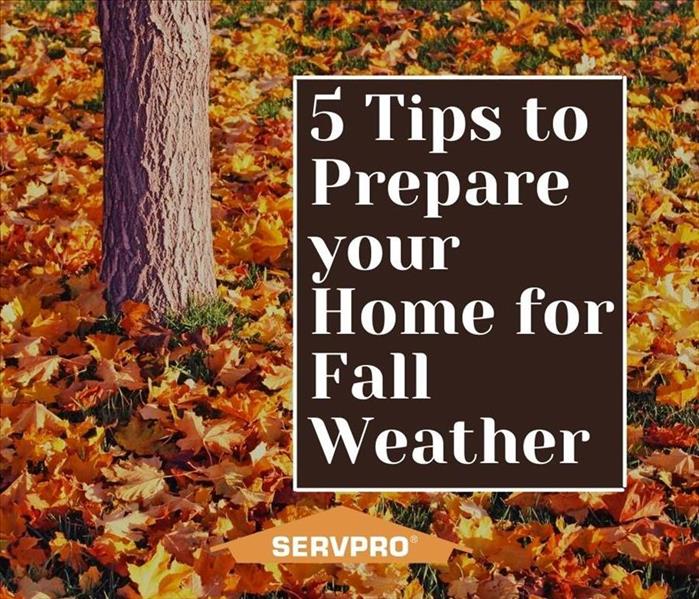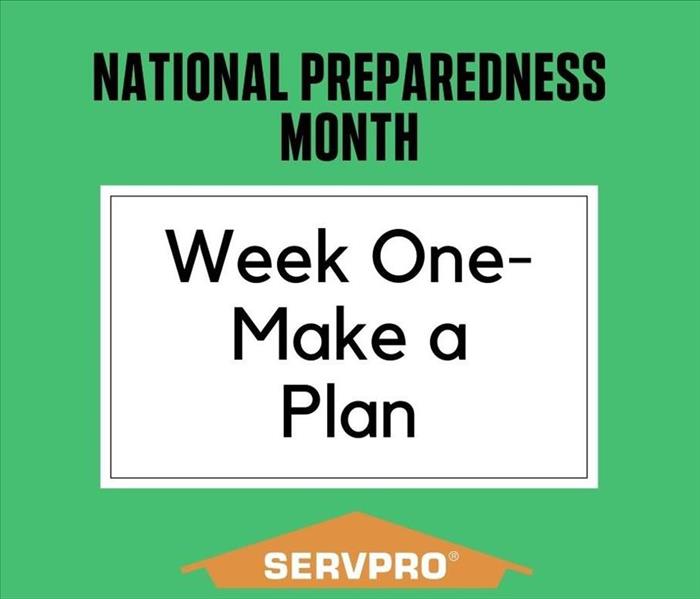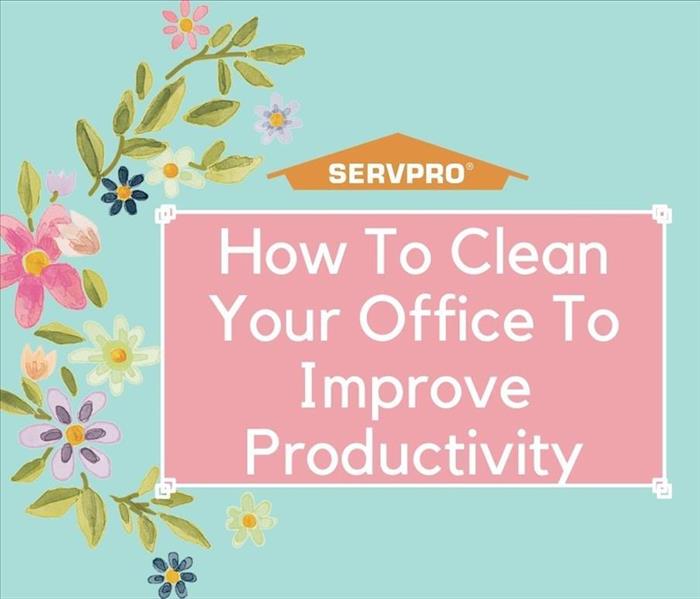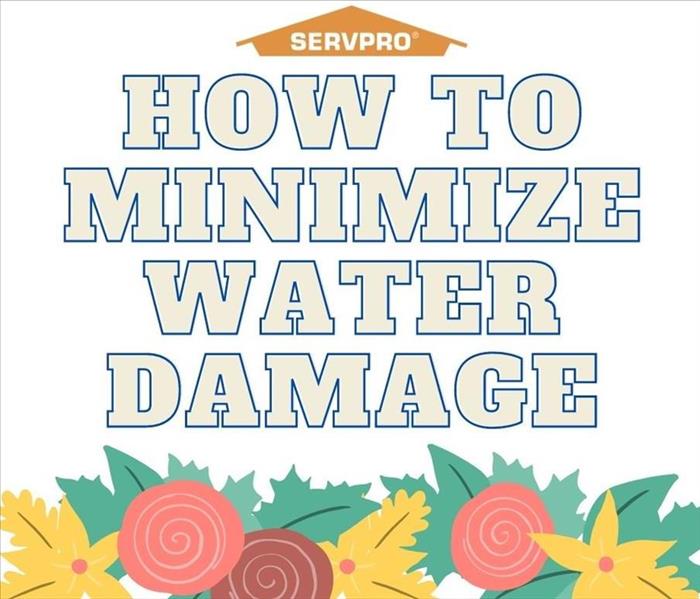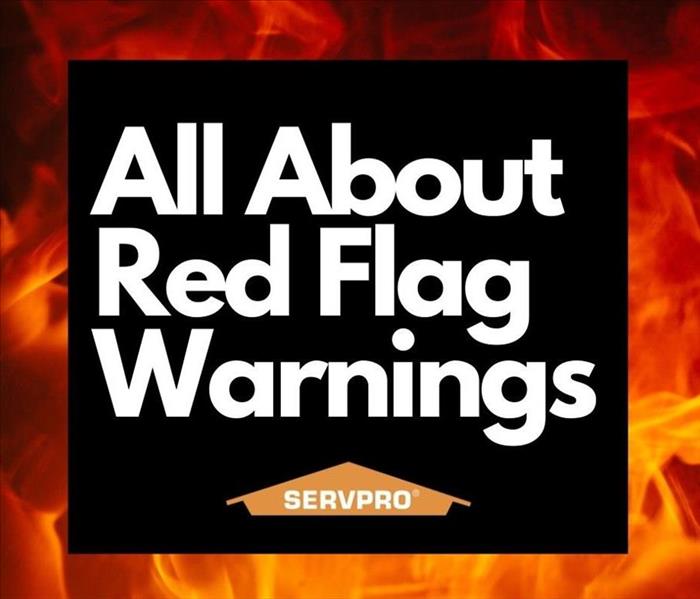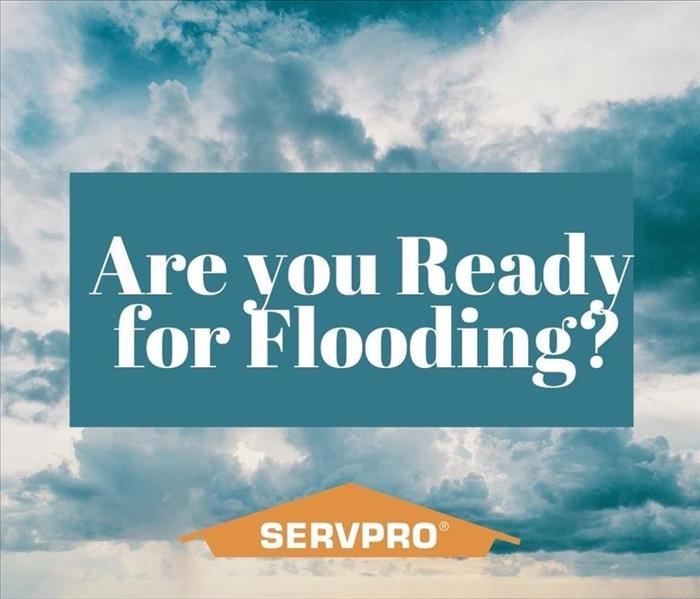Recent Posts
Spring Flooding Risks
3/1/2022 (Permalink)
The temperatures are rising which means the snow is finally melting! Spring is right around the corner and I’m so excited. However, Spring is usually a rainy season, which means we need to be prepared for floods. FEMA, or the Federal Emergency Management Agency, mentions the following risks when it comes to Spring flooding.
Spring Thaw
As the temperature rises, the snow begins to melt quite quickly, but the ground is still frozen and cannot absorb any of the moisture. This causes the water to runoff into streams, lakes or rivers, which can flood.
Spring Rains
As it begins to rain during Spring, it’s important to note that several inches of precipitation over just a few hours can oversaturate the ground and overwhelm storm drains.
Flash Flooding
Flash flooding occurs when there is a rapid flooding of low lying areas in less than 6 hours.
At SERVPRO of Norridge/Harwood Heights, we feel it’s important to talk about flooding because just a few inches of water in your home can cause thousands of dollars in damage. Make sure you and your family are prepared for any flooding by having a family evacuation plan, making an emergency kit, and by keeping any important papers in safe places. Also, look into Flood Insurance if you do not have it. According to FEMA, “Most standard homeowners policies do not cover flood damage”.
Enjoy the warmer weather, but be prepared for any flooding possibilities!
5 Tips to Prepare your Home for Fall Weather
10/21/2021 (Permalink)
Fall is our favorite season at SERVPRO of Norridge/Harwood Heights and now that the weather is getting cooler, it’s time to talk about some recommendations on how to get your home ready for fall.
- Clean your gutters- This is super important. When your gutters become clogged, they can cause damage in many different places in your home, like your foundation, your basement and your walls/ceiling. If this situation is rectified before winter, it can cause ice dams on the roof which can lead to more water damage. Check out our blog on ice dams here.
- Check for any drafts in your home- Weatherstripping your windows and doors can help prevent heat loss. Heat loss through windows is responsible for 25-30% of heating energy use.
- Change your filters- If your air filter is dirty, it’s harder for your blower fan in your HVAC system to push air, while also spreading dust, pollen and other small particles.
- Bring any outdoor furniture inside- In order to keep any outdoor furniture in its best condition, it's important to store it inside or under a tarp.
- Clean your fireplace/chimney- Your fireplace and chimney should be cleaned and inspected every 50 burns to prevent chimney fires.
These are a few of our favorite tips for getting your home ready for fall. What other recommendations do you have when it comes to preparing for fall?
National Preparedness Month- Make a Plan
9/10/2021 (Permalink)
Happy September! This month is one of our favorites and not just for pumpkin flavored drinks and the beginning of fall, but instead because it’s National Preparedness Month! Being prepared is so important to all of us at SERVPRO of Norridge/Harwood Heights. Each week has a different theme all relating to preparing oneself in case of an emergency. This week’s theme is “Make a Plan”. Today’s blog is going to be all about preparing your business for an emergency by making a plan.
Know The Risk- “By failing to prepare, you are preparing to fail”
The best way to handle an emergency is to prepare for it and have a plan. The best way to start planning is to identify all the possible scenarios that could occur at your workplace. The most common scenarios that are good to prepare for include fires, weather emergencies, etc. The next question is how do we prepare our business for these events? According to Ready.gov,
- Review hazard or threat scenarios identified during the risk assessment.
- Assess the availability and capabilities of resources for incident stabilization including people, systems and equipment available within your business and from external sources.
- Talk with public emergency services (e.g., fire, police and emergency medical services) to determine their response time to your facility, knowledge of your facility and its hazards and their capabilities to stabilize an emergency at your facility.
- Determine if there are any regulations pertaining to emergency planning at your facility; address applicable regulations in the plan.
- Develop protective actions for life safety (evacuation, shelter, shelter-in-place, lockdown).
- Develop hazard and threat-specific emergency procedures using the Emergency Response Plan for Businesses.
- Coordinate emergency planning with public emergency services to stabilize incidents involving the hazards at your facility.
- Train personnel so they can fulfill their roles and responsibilities.
- Facilitate exercises to practice your plan.
National Preparedness Month- Make a Kit
9/10/2021 (Permalink)
The second week of National Preparedness is all about building a kit. In case of an emergency, such as a flood, it’s important to have vital items that can assist you and your family in any event. Below, I’ve made a list of the most important items to put in your families’ emergency kit as suggested by Ready.gov.
- Water- You should have one gallon per person for several days.
- Food- It’s a good idea to have three days worth of nonperishable foods.
- Battery powered radio- In case of an emergency, it’s important to be able to know what’s going on and what experts are recommending.
- Flashlights
- First Aid Kit
- Extra Batteries
- Whistle- A whistle can be used to signal help if you or your family is stuck
- Prescription Medicine
- Pet food
- Important family documents (birth certificates, social security cards, any insurance information, etc.)
There are more items to consider to add to your Emergency Kit can be found on Ready.gov. Remember to keep the kit in a designated area so you can find it quickly if needed. Make sure to keep it in a dry, cool place.
It's National Grilling Month!
7/1/2021 (Permalink)
July is National Grilling Month and, while we can’t wait to celebrate all month long, we thought we should highlight some key tips to make sure everyone is grilling safely.
- Make sure your grill is at least 10 feet away from your home- Charcoal and gas grills are designed to be used outdoors only. Don’t set up your grill under wooden overhangs or any tree branches.
- Clean your grill regularly- Remove any fat/grease from the grill and the tray below the grill. If you use a charcoal grill, make sure your coals are cooled off before disposing of them in a metal container.
- Check for gas leaks- Before the season’s first barbecue, check the gas tank hose for leaks by applying a light soap and water solution to the hose and then turning on the gas. If there is a propane leak, the solution will bubble. Other signs of a propane leak include the smell of gas near the barbecue or a flame that won’t light.
- Be safe around the grill- Make sure to keep an eye on any children or pets to assure they do not play close to the grill. Never try to move a hot grill. Never leave the grill unattended.
- Always have a fire extinguisher nearby- While having the extinguisher is important, you also have to know how to use it. If you do not know how to use it, call 911. Firefighters have stated that many fire deaths occur when people attempt to fight a fire by themselves instead of calling the station.
Remember these tips to stay safe this summer. SERVPRO of Norridge/Harwood Heights hopes you have a great summer!
A Cheatsheet to Firework Safety
7/1/2021 (Permalink)
One of the most popular activities during Fourth of July celebrations is watching or lighting fireworks. However, this activity can be highly dangerous.In 2017, eight people died and over 12,000 were injured badly enough to require medical treatment after fireworks-related incidents. In today’s blog, we’re providing firework safety tips to keep your family and you safe this holiday.
One of the best tips is to leave the fireworks to the professionals. They are properly trained and have experience using fireworks.
However, if you do decide to use legal fireworks, here are our tips to keep everyone safe:
- Never allow young children to handle fireworks
- Never use fireworks while under the influence of drugs or alcohol
- Never hold lighted fireworks in your hands
- Never light them indoors
- Do not try to re-light or handle malfunctioning fireworks
- Soak both spent and unused fireworks in water for a few hours before discarding
- Never use illegal fireworks
Additionally, according to the National Safety Council, fireworks start an average of 18,500 fires each year, including 1,300 structure fires, 300 vehicle fires and nearly 17,000 other fires. Here are some tips to protect your home while others use fireworks:
- Clean out your gutters- Gutters are often clogged with flammable items such as twigs or leaves. A stray spark from a firework could hit these items and start a fire. Remove any flammable items from your gutters and also dispose of them from your yard.
- Water your plants- If your plants are dry due to drought, it could be helpful to water them before lighting any fireworks. If they’re damp, they’re less likely to catch fire if they are hit by sparks from fireworks.
- Set off fireworks far from your house- The further away the firework display is, the better off you are in terms of avoiding damage to your home.
SERVPRO of Norridge wishes everyone a Happy Independence Day!
How To Clean Your Office to Promote Productivity
6/3/2021 (Permalink)
“For every minute spent organizing, an hour is earned” -Benjamin Franklin
Our offices can inspire us to be productive, but a dirty, unorganized office can cause stress and can make a bad impression on potential clients. In today’s blog post, I want to stress the importance of clean office spaces and how to clean your office effectively.
- Organize any paperwork- Many of us accumulate different papers throughout our work day. By the end of the day, our desks can be completely covered, which can make it very difficult to find certain papers when we need them. Make sure to file any paperwork where it can be easily located.
- Clean Desk- Once all paperwork is filed and away, clean off any other items from your desk that you do not need or use daily. Also, wipe your desk to remove any dirt or dust.
- Eliminate Digital Clutter- Digital clutter can be old emails or any older documents that you've saved that you no longer need. Start with your desktop and move any documents into files where they are easier to organize and find.
- Clean Furniture- Once your desk is cleared off, use a cleaning product to really deep clean it. Dust any shelves or bookshelves and wipe down any chairs to eliminate any dirt or dust. Don’t forget to clean your computer! Did you know a typical office keyboard can carry up to 7,500 bacteria at any given time?
- Buy Any Needed Supplies- Take note of any dwindling supplies and replenish any things you may need, like staples, pens, or sticky notes.
- Add Things That Inspire You- Your office should reflect things you like and be a space that inspires you. Some nice things to add to your office could be plants, wall art, or colorful supplies.
Having a clean, inspiring office can increase productivity and morale, while also causing less stress. If you feel like you're lacking motivation, try giving your office a good deep clean!
How to Minimize Water Damage
5/11/2021 (Permalink)
Spring is the wettest time of year and though the showers bring flowers, it can also cause water damage. No matter how water damage occurs, whether by flooding/rain or a plumbing issue, it can be very expensive. The average cost of water damage restoration is over $3,000. To protect yourself and your home from water damage, first and foremost, it’s important to do any preventative measures.
The best tool against leaks and floods, is being ready beforehand. Below, I’ve compiled a list of a few tips that can help you reduce your risk of water damage in/around your home.
- Keep gutters and downspouts clear
- Check appliances for leaks regularly and fix any problems promptly
- When replacing appliances, replace the hose as well
- Consider installing water detection devices near your water heater, sump pump, washing machines or any other device at risk for leaks
- Keep a watchful eye over your water bills. A spike in the usage can give away a mystery leak
If you have noticed water damage in your home, the best plan of action is to clean it promptly. Water damage can lead to mold growth, which can cause additional damage and produce a smell. After several hours, some flooring and items will be unsalvageable if they aren’t properly dried. Here are some tips for what to do after discovering a flood or water damage in your home.
- First, shut off the water source. Find the shut off valve for the fixture or the pipe causing the leak and shut it off. If you cannot find or reach these shut offs, shut off the main water valve for your home.
- Do what you can to limit damage:use buckets or tarps to intercept the water. Move any furniture away from the wet area.
- Call your insurance company to begin a claim.
- Call SERVPRO for restoration help.
All About Red Flag Warnings
4/27/2021 (Permalink)
The National Weather Service issues many different alerts to keep people safe. While most people are familiar with alerts such as tornado warnings, severe thunderstorm warnings and high winds. One of the alerts that people are less familiar with is a Red Flag Warning.
What is a Red Flag Warning?
A Red Flag Warning is a forecast warning issued by the NWS that informs the public and firefighters that conditions are ideal for wildland fire combustion and rapid spread.
When are Red Flag Warnings issued?
They are issued when warm temperatures, low humidity, dry fuels and strong winds could combine to produce extreme fire behavior that is currently occurring or will occur in the next 24 hours.
What are some of the criteria to issue a Red Flag Warning?
- Sustained wind speeds averaging 15 MPH or greater
- Temperature over 75 ? or higher
- Relative humidity of 25% or less
Red Flag Warning Safety Tips
- Extinguish outdoor fires and never leave them unattended. Always drown fires with plenty of water.
- Soak any ashes or charcoal in water and dispose of them in a metal can.
- Remove any leaves, weeds, brush, firewood, and any other flammables such as gas cans, patio furniture, or lawnmowers from within 100 feet of your home.
- Do not throw cigarettes or matches from a moving car.
Are you Ready for Flooding?
4/9/2021 (Permalink)
It’s almost mid-April, and April showers bring May flowers, but they could also bring dangerous floods. Flooding occurs when water temporary overflows onto land that is normally dry. There are different types of floods that can occur, like a river flood, which occurs when a river rises above the river banks, or a flash flood, which is a flood that begins within 6 hours of heavy rainfall.
Floods are the most common natural disaster in the United States and can be very dangerous: just six inches of moving water can knock a person down and a foot of water can sweep away a vehicle. Never try to swim or drive through flood waters.
If you are in a flood, find shelter immediately. Depending on the type of flood:
- Evacuate if told to do so
- Move to a higher floor or higher ground
- Stay where you are
Do you know the difference between flood warnings?
FLASH FLOOD WATCH or FLOOD WATCH
Flash flooding or flooding is possible within the designated watch area — be alert.
FLASH FLOOD WARNING or FLOOD WARNING
Flash flooding or flooding has been reported or is imminent — take necessary precautions at once! Get to higher ground!
How to Prepare for a Flood-
- Make a flood emergency plan.
- Prepare an emergency preparedness kit with a flashlight, batteries, etc.
- Raise furnaces, water heaters and electrical components above the base flood elevation level. Install a sump pump system to drain water away from your home.
- Seal basement walls to prevent water seepage
For more information on floods, check out ready.gov/floods.





 24/7 Emergency Service
24/7 Emergency Service
